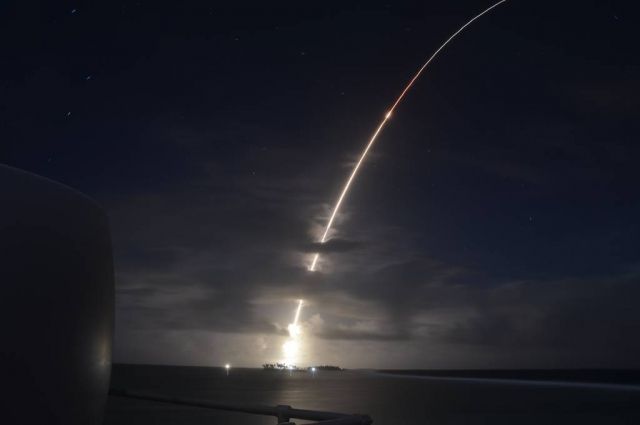
The US Missile Defense Agency has successfully tested a new launcher for the ground segment of the missile defense system. In tests, the warhead of a rocket with its own engine was successfully used, which will improve the missile by reducing the number of stages. Previously, this warhead was abandoned due to production difficulties.
The US Missile Defense Agency has successfully tested a new ground launcher. During the tests, a combat element called the Exoatmospheric Kill Vehicle (EKV) was used. Freely translated, it means “ exoatmospheric killing machine. & # 39; & # 39; It is the outer part of the Earth's atmosphere, located at an altitude of 500-1000 kilometers.
EKV & nbsp; is a missile warhead that separates into the exoatmosphere and hits the target (other missiles), colliding with their warheads. She looks for a target on the thermal track and builds trajectories with her own computer resources. EKV is heading towards & nbsp; target with & nbsp; precision to & nbsp; a few millimeters and destroyed & nbsp; head of a one-hit alien missile. & Nbsp;
EKV & nbsp; is part of the ground interceptor GBI (Ground Based Interceptor), which is under development. It is intended for the destruction of intercontinental ballistic missiles and their warheads in outer space outside the Earth's atmosphere. Upon its inception, possible single missile attacks from Iran and North Korea were officially designated as a threat.
EKV & nbsp; was developed for & nbsp; improve the characteristics of the weapon on the & nbsp; cruise phase of flight & mdash; the flight segment of the rocket, on which its engine works. Thanks to EKV engines, the entire rocket can be two-stage, not three. This will allow you to choose between two-stage and & nbsp; to three stages according to & nbsp; where is the target and & nbsp; how fast it is moving.
In the opinion of the military, the two-stage GBI would extend the reach of the national missile defense system. It would separate & nbsp; the interceptor about & nbsp; 70 & nbsp; earlier than a three-stage interceptor.
Several options to complete the missile defense system have been developed. Initially, the US ground-based anti-missile system was equipped only with EKVs. Next, in the US ground-based missile defense system, it was supposed to use multiple kinetic interceptors. It was expected that each aircraft carrier will carry a set of & nbsp; six interceptors, which will be guided by their own sensors and correct the flight path.
However, these two systems were constantly experiencing problems. In & nbsp; 2010, the production of EKV was even suspended due to & nbsp; the need to eliminate the defects identified in the & nbsp; conduct of two unsuccessful launches. & Nbsp;
Therefore, & nbsp; The US Missile Defense Agency has started the development of a fundamentally new interceptor & mdash; Redesigned Kill Vehicle (RKV), which can be translated as a 'redesigned machine for & nbsp; to kill. & # 39; & # 39;
In August 2019, failure befell this direction of improvement of the missile defense system & nbsp; USA & mdash; it was decided to & nbsp; to close the program of creation of promising kinetic interceptors RKV and to break the corresponding contract with & nbsp; Boeing Corporation & nbsp; worth over $ 1 billion.
The attempt to redesign the EKV units was abandoned due to difficulties in & nbsp; compliance with technical requirements: the client & nbsp; wanted the system to have interceptors capable of destroying ever-improving intercontinental ballistic missiles of a potential enemy.
The Pentagon & nbsp; decided that there would be no more investment in & nbsp; the development of interceptor missiles and interceptors of this type, and will focus on & nbsp; the creation of next-generation interceptor missiles & nbsp; New generation interseptor. They must be part of the same missile defense system. & Nbsp;
During the last flight tests, the EKV model was successfully launched. This suggests that the project & nbsp; at least has the right to exist.
https://www.defensenews.com/2021/09/12/missile-defense-agency-successfully-tests-new – booster-for-homeland-missile-defense-system/


